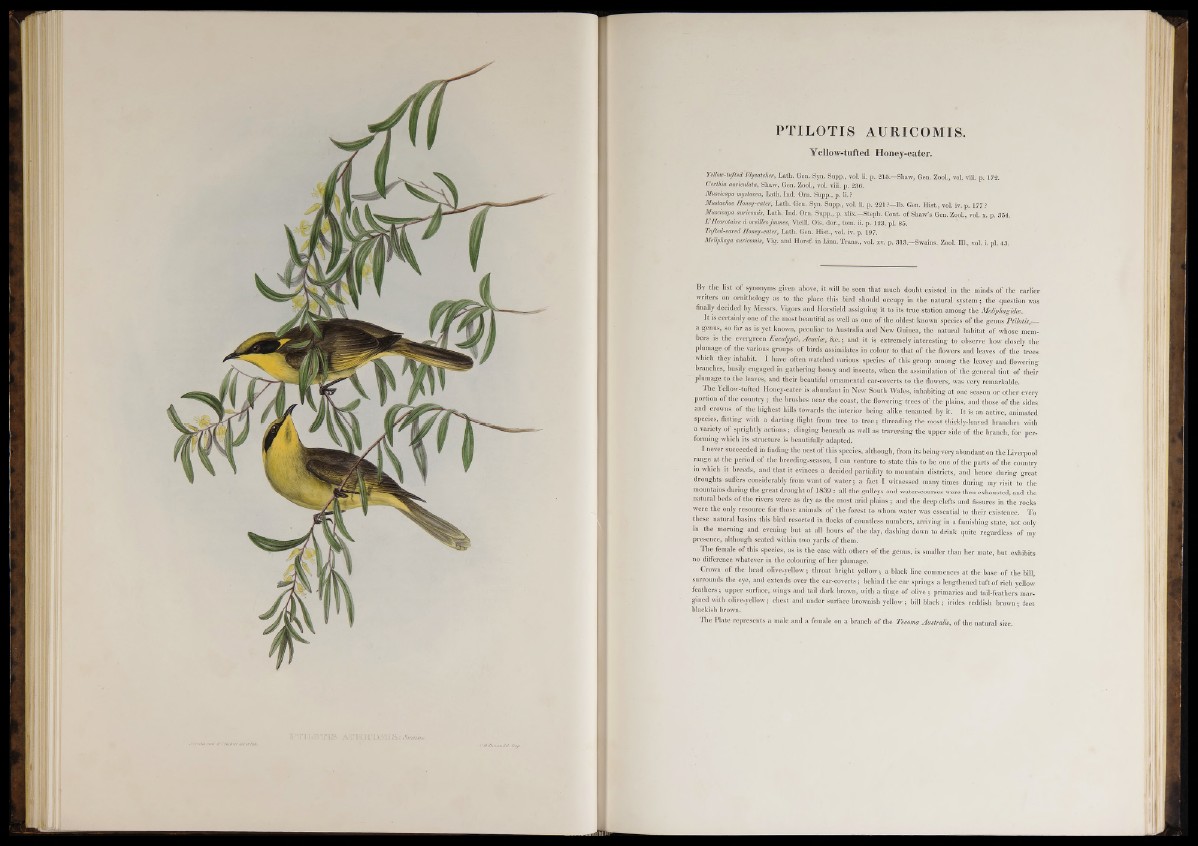
PTILOTIS AURICOMIS.
Yellow-tufted Honey-eater.
YeUm-tufki Flycatcher, Lath. Gen. Syn. Supp., vol. ii. p. 215—Shaw, Gen. Zool., voL yiii. p. 172.
Certhia auriculata, Shaw, Gen. Zool., vol. viii. p. 236.
Muscicapa mystacea, Lath. Ind. Orn. Supp., p. I.?
Mustachoe Honey-eater, Lath. Gen. Syn. Supp., vol. ii. p. 221 ?—’Ib. Gen. Hist., vol. iv. p. 1 7 0
Muscicapa auricomis, Lath. Ind. Orn. Supp., p. xlix,—Steph. Cont. of Shaw’s Gen. Zool., vol. x. p. 364.
L’Heorotaire doreilles jaunes, Vieill. Ois. dor., tom. ii. p. 123. pi. 85.
Tufted-eared Honey-eater, Lath. Gen. Hist., vol. iv. p. 197.
Meliphaga auricomis, Vig. and Horsf. in Linn. Trans., vol. xv. p. 313.—Swains. Zool. 111., vol.. i. pi. 43.
By the list o f synonyms given above, it will be seen that much doubt existed in the minds o f the earlier
writers on ornithology as to the place this bird should occupy in the natural system ; the question was
finally decided by Messrs. Vigors and Horsfield assigning it to its true station among the Meliphagida.
It is certainly one o f the most beautiful as well as one of the oldest known species of the genus Ptilotis,—
a genus, so far as is yet known, peculiar to Australia and New Guinea, the natural habitat o f whose members
is the evergreen Eucalypti, Acacia, &c . ; and it is extremely interesting to observe how closely the
plumage o f the various groups of birds assimilates in colour to that of the flowers and leaves o f the trees
which they inhabit. I have often watched various species o f this group among the leavey and flowering
branches, busily engaged in gathering honey and insects, when the assimilation of the general tint of their
plumage to the leaves, and their beautiful ornamental ear-coyerts to the flowers, was very remarkable.
The Yellow-tufted Honey-eater is abundant in New South Wales, inhabiting at one season or other every
portion of the country; the brushes near the coast, the flowering trees of the plains, and those o f the sides;
and crowns o f the highest hills towards the interior being alike tenanted by it. It is an active, animated
species, flitting with a darting flight from tree to tre e ; threading the most thickly-leaved branches with
a variety of sprightly actions; clinging beneath as well as traversing the upper side of the branch, for performing
which its structure is beautifully adapted.
I never succeeded in finding the nest o f this species, although, from its heing very abundant on the Liverpool
range at the period o f the breeding-season, I can venture to state this to be one o f the parts of the country
in which it breeds, and that it evinces a decided partiality to mountain districts, and hence during great
droughts suffers considerably from want of water; a fact 1 witnessed many times during my visit to the
mountains during the great drought o f 1839 : all the gulleys and water-courses were then exhausted, and the
natural beds o f the rivers were as dry as the most arid plains; and the deep clefts and fissures in the rocks
were the only resource for those animals of the forest to whom water was essential to their existence. To
these natural basins this bird resorted in flocks o f countless numbers, arriving in a famishing state, not only
in the morning and evening but at all hours o f the day, dashing down to drink quite regardless o f my
presence, although seated within two yards o f them.
The female of this species, as is the case with others of the genus, is smaller than her mate, but exhibits
no difference whatever in the colouring of her plumage.
Crown o f the head olive-yellow; throat bright yellow; a black line commences at the base o f the bill,
surrounds the eye, and extends over the ear-coverts; behind the ear springs a lengthened tuft o f rich yellow
feathers; upper surface, wings and tail dark brown, with a tinge o f olive; primaries and tail-feathers margined
with olive-yellow; chest and under surface brownish yellow; bill black ; irides reddish brown; feet
blackish brown.
The Plate represents a male and a female on a branch of the Tecoma Australis, of the natural size.